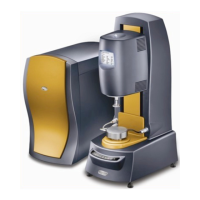DHR Series Getting Started Guide Page 22
Magnetically-Levitated Bearing
All CMT rheometers contain a bearing, and it is this component that largely controls the quality of data
that can be obtained on the instrument. The design of a bearing is a compromise involving several proper-
ties such as friction, stiffness, air consumption and tolerance to contamination and misuse. To keep the fric-
tion low, non-contact bearings have always been used in the better quality rheometers. A thrust disc is
mounted horizontally on the rotating spindle of the rheometer and, on traditional instruments, this disc is
supported within a chamber by air introduced from below at high pressure. To prevent the spindle moving
upwards, air is also introduced into the chamber from above, and to prevent it moving laterally, radial air-
bearings are used.
In the Discovery Series rheometers, the thrust disc is retained, but it is levitated magnetically. The thrust
disc is constructed from a magnetically susceptible material. Electromagnetic actuators are positioned
above and below the disc, the strength of the magnetic field generated by each actuator is controlled
through the current supplied to its coils. The stronger the field, the greater the attraction between the actua-
tor and the thrust disc. The axial position and motion of the spindle are detected by sensors mounted above
the upper actuator, and can be closely controlled by varying the supplied current to each actuator coil.
This arrangement has advantages over the traditional air-bearing in many respects. The gap between the
thrust disc and the stationary components of the instrument can be much wider, of the order of millimeters
rather than micrometers. This results in both the friction of the bearing being substantially lower, and
increases the smoothness of rotation. The latter is particularly important, since it means that the variation in
the bearing characteristics with angular position, that are inevitable for any real bearing, can be more easily
allowed for by calibration (“mapping”). The axial stiffness of the bearing is increased, because of the tight-
ness of the control loop governing the axial position (to prevent lateral movement of the shaft, radial air-
bearings are used). The air consumption is reduced, and the wider gap and more durable materials used
make the bearing more robust and less susceptible to contamination.
Figure 7 DHR motor bearing.
Encoder
Thrust bearing
Radial bearings
Drag cup
True position sensor

